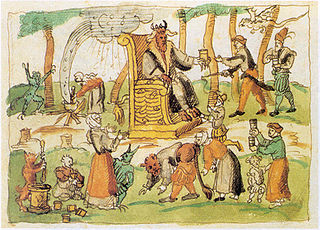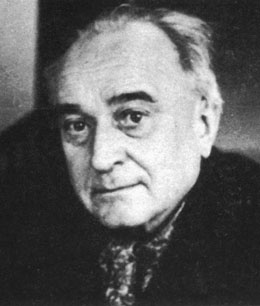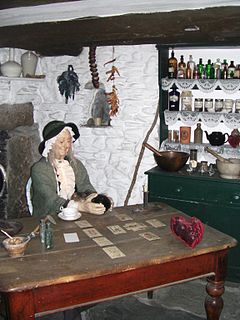
Witchcraft traditionally means the use of magic or supernatural powers to harm others. A practitioner is a witch. In medieval and early modern Europe, where the term originated, accused witches were usually women who were believed to have attacked their own community, and often to have communed with evil beings. It was thought witchcraft could be thwarted by protective magic or counter-magic, which could be provided by cunning folk or folk healers. Suspected witches were also intimidated, banished, attacked or killed. Often they would be formally prosecuted and punished, if found guilty or simply believed to be guilty. European witch-hunts and witch trials in the early modern period led to tens of thousands of executions. Although some folk healers were accused of witchcraft, they made up a minority of those accused. European belief in witchcraft gradually dwindled during and after the Age of Enlightenment.

A witch-hunt, or a witch purge, is a search for people who have been labeled witches or a search for evidence of witchcraft. The classical period of witch-hunts in Early Modern Europe and Colonial America took place in the Early Modern period or about 1450 to 1750, spanning the upheavals of the Reformation and the Thirty Years' War, resulting in an estimated 35,000 to 50,000 executions. The last executions of people convicted as witches in Europe took place in the 18th century. In other regions, like Africa and Asia, contemporary witch-hunts have been reported from sub-Saharan Africa and Papua New Guinea, and official legislation against witchcraft is still found in Saudi Arabia and Cameroon today.
Christian views on magic vary widely among denominations and among individuals. Many Christians actively condemn magic as satanic, holding that it opens the way for demonic possession. Some Christians simply view it as entertainment. Conversely, some branches of esoteric Christianity actively engage in magical practices.

The Azande are an Ubangian ethnic group in Central Africa. They live primarily in the northeastern part of the Democratic Republic of the Congo, in south-central and southwestern part of South Sudan, and in southeastern Central African Republic. The Congolese Azande live in Orientale Province, specifically along the Uele River; Isiro, Dungu, Kisangani and Duruma. The Central African Azande live in the districts of Rafaï, Bangasu and Obo. The Azande of South Sudan live in Central, Western Equatoria and Western Bahr al-Ghazal States, Yei, Maridi, Yambio, Tombura, Deim Zubeir, Wau Town and Momoi.

A Witches' Sabbath is a purported gathering of those believed to practice witchcraft and other rituals. The phrase became popular in the 20th century.

In European folklore of the medieval and early modern periods, familiars were believed to be supernatural entities that would assist witches and cunning folk in their practice of magic. According to records of the time, those alleging to have had contact with familiar spirits reported that they could manifest as numerous forms, usually as an animal, but sometimes as a human or humanoid figure, and were described as "clearly defined, three-dimensional... forms, vivid with colour and animated with movement and sound", as opposed to descriptions of ghosts with their "smoky, undefined form[s]".

Sir Edward Evan Evans-Pritchard, Kt FBA FRAI was an English anthropologist who was instrumental in the development of social anthropology. He was Professor of Social Anthropology at the University of Oxford from 1946 to 1970.

A witch doctor was originally a type of healer who treated ailments believed to be caused by witchcraft. The term is now more commonly used to refer to healers, particularly in regions which use traditional healing rather than contemporary medicine.

The cunning folk in Britain were professional or semi-professional practitioners of magic in Britain, active from the Medieval period through the early twentieth century. As cunning folk, they practised folk magic – also known as "low magic" – although often combined with elements of "high" or ceremonial magic, which they learned through the study of grimoires. Primarily using spells and charms as a part of their profession, they were most commonly employed to use their magic in order to combat malevolent witchcraft, to locate criminals, missing persons or stolen property, for fortune telling, for healing, for treasure hunting and to influence people to fall in love. Belonging "to the world of popular belief and custom", the cunning folk's magic has been defined as being "concerned not with the mysteries of the universe and the empowerment of the magus [as ceremonial magic usually is], so much as with practical remedies for specific problems." However, other historians have noted that in some cases, there was apparently an "experimental or 'spiritual' dimension" to their magical practices, something which was possibly shamanic in nature.
Obeah is a system of spiritual healing and justice-making practices developed among enslaved West Africana in the West Indies. Obeah is difficult to define, as it is not a single, unified set of practices; the word "Obeah" was historically not often used to describe one's own practices.

Tituba was an enslaved girl who was the first female to be accused of practicing witchcraft during the 1692 Salem witch trials. Although her origins are debated, historical research has suggested that she was a Kalina woman from Tibitó who eventually ended up in Barbados, where she was purchased by the Puritan priest Samuel Parris, who brought her to colonial Massachusetts. Little is known about Tituba's life prior to her enslavement. It is said that she was named after the tribe or the town which she came from. She became a pivotal figure in the witch trials when she confessed to practicing witchcraft while she was also making claims that both Sarah Good and Sarah Osborne participated in the said witchcraft. She was imprisoned and was then later released by Samuel Conklin.

Bridget Bishop was the first person executed for witchcraft during the Salem witch trials in 1692. Nineteen were hanged, and one, Giles Corey, was pressed to death. Altogether, about 200 people were tried.

Belief in witchcraft in Europe can be traced to classical antiquity and has continuous history during the Middle Ages, culminating in the Early Modern witch trials and giving rise to the fairy tale and popular culture "witch" stock character of modern times, as well as to the concept of the "modern witch" in Wicca and related movements of contemporary witchcraft.

The Bideford witch trial resulted in hangings for witchcraft in England. Temperance Lloyd, Mary Trembles and Susannah Edwards from the town of Bideford in Devon were tried in 1682 at the Exeter Assizes at Rougemont Castle. Much of the evidence against them was hearsay, although there was a confession by Lloyd, which she did not fully recant even with her execution imminent. These women have been labelled as the last witches to be hanged in England, but there are subsequent cases which are not as well documented.
Medical explanations of bewitchment, especially as exhibited during the Salem witch trials but in other witch-hunts as well, have emerged because it is not widely believed today that symptoms of those claiming affliction were actually caused by bewitchment. The reported symptoms have been explored by a variety of researchers for possible biological and psychological origins.
Maleficium as a Latin term, "An act of witchcraft performed with the intention of causing damage or injury; the resultant harm." In general, the term applies to any magical act intended to cause harm or death to people or property. Its modern spelling comes from "Early 17th century; earliest use found in George Abbot (1562–1633), archbishop of Canterbury. From classical Latin maleficium evil deed, injury, sorcery from maleficus + -ium". In general, the term applies to any magical act intended to cause harm or death to people or property.

Cunning folk, also known as folk healers or wise folk, were practitioners of folk medicine, helpful folk magic and divination in Europe from the Middle Ages until the 20th century. Their practices were known as the cunning craft. Their services also included thwarting witchcraft. Although some cunning folk were denounced as witches themselves, they made up a minority of those accused, and the common people generally made a distinction between the two. The name 'cunning folk' originally referred to folk-healers and magic-workers in Britain, but the name is now applied as an umbrella term for similar people in other parts of Europe.

Witchcraft among the Zande people of North Central Africa is magic used to inflict harm on an individual that is native to the Azande tribal peoples. The belief in witchcraft is present in every aspect of Zande society. They believe it is a power that can only be passed on from a parent to their child. To the Azande, a witch uses witchcraft when he has hatred towards another person. Witchcraft can also manipulate nature to bring harm upon the victim of the witch. Oracles and witch doctors determine whether someone is guilty of using witchcraft on another villager. More magic is then created to avenge the victim and punish the one who committed the transgression.

Witchcraft is deeply rooted in many African countries and communities in Sub-Saharan Africa. It has been specifically relevant in Ghana's culture, beliefs, and lifestyle and continues to shape lives on the daily. It has promoted tradition, fear, violence, and spiritual beliefs. The perceptions on witchcraft change from region to region within Ghana as it does in other countries in Africa, with the commonality that it is not something to take lightly and the word spreading fast if there are rumors surrounding civilians practicing it. The actions taken by local citizens and the government towards witchcraft and violence related to it has also varied within regions in Ghana. Traditional African religions have depicted the universe as a multitude of spirits that are able to be used for either good or evil through religion.
Unlike neighboring England and Scotland, there were few witchcraft accusations and trials in Wales throughout the 1500s to mid-1700s, and most of the accused were acquitted. Only five people were executed in Wales for witchcraft during this period.













